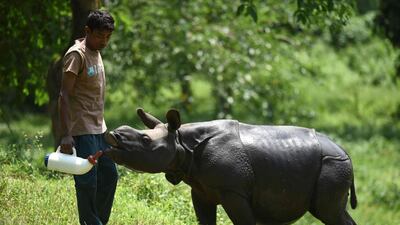KAZIRANGA, INDIA // As night falls over the lush plains of India’s Kaziranga national park, a small group of lightly armed forest guards sets out on foot to protect the world’s largest population of one-horned rhinos.
These men with their ageing rifles and small plastic torches are on the front line of the battle against increasingly sophisticated international poaching networks that prey on the rare animals, entering the park under cover of darkness to kill them for their horns.
A decade ago, India had all but declared victory over poaching in Kaziranga, a 430-square-kilometre protected area of forest in the north-eastern state of Assam that is home to around 2,500 rhinos.
But recent years have seen an alarming upsurge in the slaughter of the animals, whose horn is highly prized in neighbouring China and in Vietnam.
At least a dozen rhinos have been poached in Kaziranga in the first six months of this year – more than twice the number killed in the whole of 2006.
“The poaching network has become more systematic, stronger, more efficient,” said Amit Sharma, senior coordinator for rhino conservation at WWF India, who blames a surge in demand that has seen prices top $100,000 (Dh367,270) per kilo for the final product.
“The value of a horn has shot up like anything, that is why people are ready to risk their lives,” he added.
Park rangers say they are woefully under-equipped to deal with the modern, sophisticated weapons used by the poachers, including AK47s and night-vision goggles.
Many of the myriad insurgent groups operating in India’s restive north-east are involved in the trade, which passes through the neighbouring state of Nagaland into Myanmar before being smuggled to China.
The issue is hugely emotive in Assam, where the rhino is both a source of pride and a big tourist draw.
It hit global headlines in April, when a rhino was poached on the very day that Britain’s Prince William and his wife Kate visited the national park.
“Many years ago you would see rhinos everywhere around here,” said local villager Damayanti Chhetri. “The poachers have no heart.”
Local people are a vital source of information for the park rangers, providing tip-offs about upcoming poaching raids.
But some are also being paid by the poachers, who rely on their knowledge of the local terrain, according to one senior forest official.
“Locals know every corner of the park. Huge money is involved. It is a risky job, and still they do it,” said the official.
The risks are high: Kaziranga’s forest guards have the right to shoot suspected poachers on sight, and dozens have been killed over the last decade.
The policy is controversial, but they argue it is justified as no one is allowed to enter the park without permission.
“If we see someone, without any enquiry we can shoot. We will presume that he is a poacher,” said one guard who had killed a suspected poacher.
Assam’s new forests minister Pramila Rani Brahma said in Guwahati that local poverty was fuelling the trade in rhino horn.
But she has also ordered an investigation into forest officials suspected of collusion with the poachers.
WWF India’s Mr Sharma does not believe park authorities are complicit in the trade, but says the pressure they are under may be leading them to cover up incidents of poaching.
For Mr Sharma, the priority should be to provide the struggling forest guards with better equipment.
“The backbone on which we are trying to save our rhinos needs to be strengthened,” he said.
“They are our footsoldiers, without them we cannot protect our rhinos.”
* Agence France-Presse

